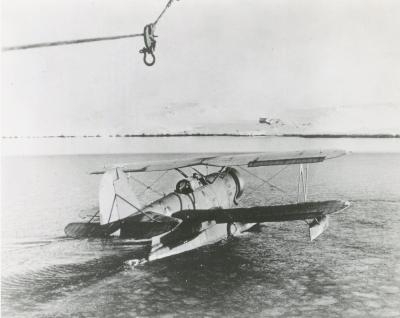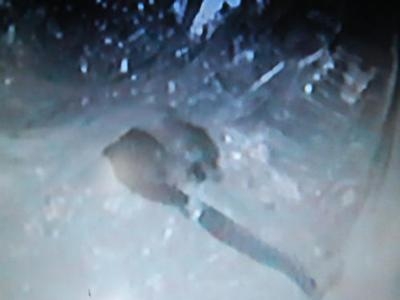Three Men Fatally Injured When The Plane Went Down In Greenland
The Defense Department's Joint POW/MIA Personnel Accounting Command said an exhaustive search by an expedition team of U.S. Coast Guard service members and North South Polar, Inc. Scientists and explorers has produced sufficient evidence that the crash site of a WWII Coast Guard Grumman Duck rescue aircraft missing for 70 years with three men aboard, beneath the ice near Koge Bay, Greenland, has been found, Coast Guard officials announced Monday.

By using historical information, ground penetrating radar, a magnetometer and metal detection equipment, the expedition team isolated the location where the aircrew crashed on Nov. 29, 1942. The team then melted five six-inch-wide holes deep into the ice and lowered a specially designed camera scope. At approximately 38 feet below the ice surface in the second hole, the team observed black cables consistent with wiring used in WWII-era J2F-4 amphibious Grumman aircraft.
Further analysis of video from the camera scope and photographs captured by a member of the expedition team revealed additional aircraft components similar to those found in the engine area of the J2F-4 Grumman Duck. “Locating the J2F-4 Grumman Duck was a monumental success,” said Cmdr. Jim Blow, from the U.S. Coast Guard Office of Aviation Forces. “Collectively, the Coast Guard and NSP accomplished what the Coast Guard set out to achieve in 2008 when efforts began to locate the Duck.”
For nearly three years, Coast Guard and NSP have been working together on this project researching historical documentation about the last flight of U.S. Coast Guard Lt. John Pritchard, Petty Officer 1st Class Benjamin Bottoms and U.S. Army Air Force Cpl. Loren Howarth aboard the Duck. “The three men aboard this aircraft were heroes who made the ultimate sacrifice for their country,” Blow added. “The story of the Grumman Duck reflects the history and the mission of the Coast Guard, and by finding the aircraft we have begun to repay our country’s debt to them.”
Information was obtained, analyzed and cross-referenced to formulate the primary points of interest to search during the course of the Coast Guard-sponsored expedition. Once at the remote location on Greenland’s southeast coast, the joint 17-member Coast Guard/NSP teams, consisting of safety personnel and scientific analysts, searched 10 POIs, nine with negative results. It wasn’t until the end of the seven-day expedition that the team, utilizing the ground penetrating radar, swept an additional historical position and made the strongest radar contact. This ultimately led to the location of the Duck. “It was an incredible experience to hear the team announce over the hand-held radio that they located aircraft components within the second bore-hole,” said Lou Sapienza, CEO of North South Polar, Inc. “We’ve spent nearly three years of research planning for this moment. There is nothing more meaningful than to have the family members of the lost aircrew know
we’ve located the site of the Duck.”

The Duck’s last flight, with Pritchard at the controls and Bottoms serving as radioman, was an attempt to rescue seven members of a U.S. Army Air Force B-17 Air Transport Command crew that had crashed during a search mission on Nov. 9, 1942. On Nov. 28, 1942, Pritchard and Bottoms had successfully flown the Duck to rescue two members of the B-17 crew during an unprecedented landing on the Greenland Ice Cap. When the two Coast Guardsmen returned the following day, they picked up Howarth, the B-17’s radioman. They were attempting to reach the Coast Guard Cutter Northland when they encountered whiteout conditions and crashed. The wrecked Duck was first spotted a week later by a U.S. Army aircrew, which reported no signs of life. The remaining B-17 crewmen were sustained with air drops until they were rescued approximately six months later.
The Coast Guard is coordinating efforts with the Joint POW/MIA Personnel Accounting Command on future actions for this site.
(Images: Top: The Coast Guard amphibian plane (J2F) has been put over the side, and Lieutenant John A. Pritchard, Jr. and Radioman Benjamin A. Bottoms, ready for the take-off, scan the Greenland icebergs over which they have spent so many hours of hazardous flying in their single-engine plane. They successfully rescued two of the U.S. Army fliers and met their death in an attempt to rescue the [sic] third flier."; no date; Photo No. (Rel. No.) 06-19-43 (03); photographer not listed.
Bottom: Possible wreckage of the WWII Coast Guard J2F-4 Grumman Duck rescue aircraft missing for 70 years with three men aboard, beneath the ice near Koge Bay, Greenland, Aug. 29, 2012. An expedition team of Coast Guard servicemembers and North South Polar, Inc. Scientists and explorers located the crash site. U.S. Coast Guard photo by Mitchell Zuckoff.)
 ANN's Daily Aero-Term (05.01.24): Say Altitude
ANN's Daily Aero-Term (05.01.24): Say Altitude ANN's Daily Aero-Linx (05.01.24)
ANN's Daily Aero-Linx (05.01.24) Classic Aero-TV: Korean War Hero Twice Reborn
Classic Aero-TV: Korean War Hero Twice Reborn Airborne 04.29.24: EAA B-25 Rides, Textron 2024, G700 Deliveries
Airborne 04.29.24: EAA B-25 Rides, Textron 2024, G700 Deliveries Airborne Affordable Flyers 05.02.24: Bobby Bailey, SPRG Report Cards, Skydive!
Airborne Affordable Flyers 05.02.24: Bobby Bailey, SPRG Report Cards, Skydive!




